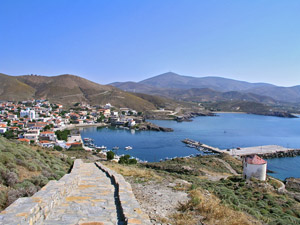Chios Island is a Greek Island located at the East Aegean Sea, close to Turkey. Throughout history Chios played always an important role due to its strategic location.
Chios island is extremely interestic with plenty to see. The numerous beaches of Chios Island (well over 60) will satisfy even the most demanding visitor.
Make sure you have enough time to get to know this marvelous island, which is the fifth (in size) island of Greece.
Watch a video with some of the interesting places in Chios island
(unfortunately available only with Greek commendation)
Σύντομη ιστορία της πόλης:
Chios town is the capital, the administrative, economic and cultural center of the island of Chios. It has a population of 30,000 and it is situated on the east coast of the island. Archaeological discoveries have shown that Chios has been inhabited continually since 6000 BC. The ancient city was built by Greeks shortly before 1000 BC.
From the ancient years until now, Chios has experienced long periods of prosperity and decline and in each rebuilding, the city has always covered about the same geographic area. For this reason, one can find evidence in the modern city from all periods of its long history.
Αξιοθέατα πόλης:
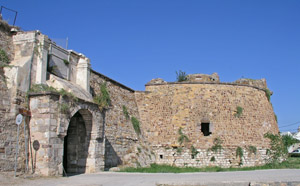
During Ancient times the city of Chios spent periods of great economic and intellectual wealth. Apart from being famous for its formidable navy and for its great commercial strength (which profoundly affected scientific and cultural growth) Chios is regarded as the birth place of the greatest poet of Ancient times Homer. Chios was undoubtedly one of the most important cities of the Greek Colonies in Ionia (Asia Minor). During the Roman Period Chios declined but in the Byzantine era recovered and for about 1000 years it became one of its most important provinces.
Chios town is the capital, the administrative, economic and cultural center of the island of Chios. It has a population of 30,000 and it is situated on the east coast of the island. Archaeological discoveries have shown that Chios has been inhabited continually since 6000 BC. The ancient city was built by Greeks shortly before 1000 BC.
From the ancient years until now, Chios has experienced long periods of prosperity and decline and in each rebuilding, the city has always covered about the same geographic area. For this reason, one can find evidence in the modern city from all periods of its long history.
In 1346 it was occupied by the Genoese. In 1566 the Ottoman Turks, having already conquered the Byzantine Empire drove out the Genoese, took Chios and occupied it until 1912. In that year Chios was liberated and became part of the rest of Greece.
The numerous remains of Chios historical past are everywhere to be witnessed and enjoyed.
The Archaeological Museum of Chios is located at Museum str, about 100m southern of the port.
The Byzantine Museum of Chios is located right at the main square of the island, called Vounaki. The building of the museum is the old Ottoman mosque.
The Giustiniani Palace is a small building right at the main entrance of the Castle of Chios. It was the house of the Genoan family of Giustiniani who ruled the island during a larg7e period of the middle ages. Now it serves as a small medieval museum.
The Chios Maritime Museum. Chios is well known for having a strong maritime presence over the years. Even now Chians are the owners of more than half of the whole Greek merchandise fleet, one of the biggest worldwide.
Koraes Library:
The Koraes Library & Argenti Folklore Museum is located in the same building at Koraes str. in the center of town, next to the Cathedral. It is one of the oldest and biggest Libraries in Greece, certainly a worth visiting monument. Among other things you may see the books of Adamantios Koraes, some of them given to him as a gift by the French Emperor Napoleon.
The Public Art Gallery of Chios is located at Andreas Syngros str. in the city center just a few meters away from the main Chios square, called Vounaki square.

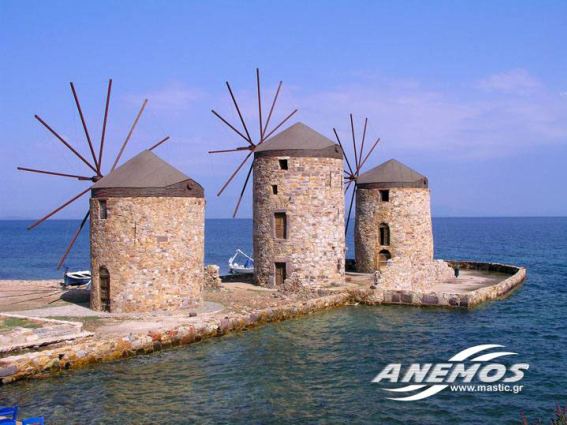
Wind Mills
You can see an example of them in the lower left part of the photo and in the photo below.
They are 1.5km from the center of town to the north (in top part of the photo you can see the main port of the town)
These wind mills were part of a small scale industrial production of Chios.
Kampos
One of the most beautiful areas of the island is Kambos, a green valley 3 Km south of town covered with citrus orchards. Kambos is a flat land that stretches, along the east coast of the island of Chios, about 10 Km long and 2 Km wide.
In the 14th century, the Genoese selected this area to build their mansions, as did the local aristocrats in later years, creating a new socio-economic level. High walls made from Thymiana stone protected the mansions and the orchards from dust, winds and cold. In the past, the orchards were watered from big wells. Water was drawn by huge water wheels turned by animals.
Elaborate cisterns decorated with marble reliefs and spouts, figure centrally in the courtyards. Shady paths, gardens of flowers, and creeping vines of jasmine create a unique atmosphere.
Chios is well know for its excellent mandarins (tangerines) with their exquisite aroma. These citrus fruits maily come from the area of Kampos.
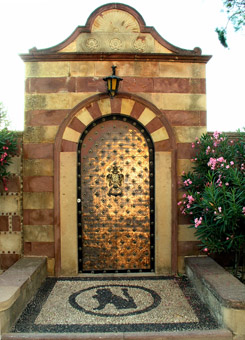
Central Chios
Karfas
is located 7 Km south of the town of Chios and is among the most well-known and loveliest beaches of Chios, with a fine golden sand, suitable for beach games and relaxed sunbathing. Ideal for children because the water is warm and the sea very shallow.
Being a tourist center, Karfas has many hotels, apartments, studios, restaurants, taverns, bars offering all the tourist facilities.
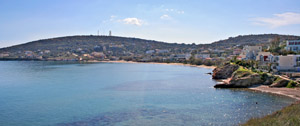

Thimiana
7 km to the South of the city of Chios Thimiana village is located. It is among the larger villages on the island with approximately 1600 inhabitants. The village is renowned for its many quarries from which the „Thymiana“ stone was extracted in many shades of brown and red. Many mansions and churches in kampos are built with this stone.
The village of Thymiana has a primary school, sports associations, a swimming club, a cultural club as well as the large church dedicated to Aghios Efstratios, a masterpiece of local architecture, also built with the well-known Thymiana stone.
Avgonyma
On the main road of central-western Chios, after passing, karyes on our route to the west, in a distance of 16 Km from Chios town, on a rocky hill, there is the graphic village of Avgonyma with very few residents. The houses are built with local stone. During the sunset, the view of the Aegean sea and Psara island, the bay of Elinda is unique.
Anavatos
The village of Anavatos, 16 Km from town, is built on a conical cliff 450 meters above sea level, with steep sides to the south and west, and with only a single access to the north.
The people took advantage of the natural fortification of this cliff and strengthened it with a circular wall surrounding the houses that seem to be glued, one to the other. Together with the cliff, the village made up the defensive perimeter of the fortress.
The 400 houses inside the walls were narrow and built of grey stone taken from the same mountain. As a result, you can hardly distiguise the village from far away. The buildings have flat wooden roofs, low doors and tiny windows.
The village was abandoned after the slaughters of Chios by Turks in 1822 and in our days it is a National Monument for all the Chians and Greeks.
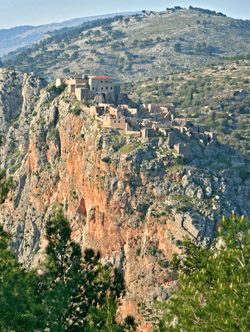

Lithi
It is situated 4 Km north of Vessa (at a distance of 23.5 Km from the town of Chios). There are three caves in the area, but not yet fully explored.
Lithi is a famous fishing village. Traditionally, the main occupation of its inhabitants has been fishing.
It is worth visiting its sandy beach for a relaxed swim in the beautiful sea. There are plenty of taverns for enjoying eating local fresh fish and seafood in general. Also there are some small hotels and rooms to let if you want to stay a few days and enjoy the sea and the fresh fish.
The sunset at Lithi is unforgettable.
Nea Moni
(New Monastery) is a monument of international significance. The catholicon (main church) is the most important specimen of the insular octagonal domed type of church and is lavishly decorated with marble revetments and mosaics. Nea Moni was founded in the middle of the 11th century, with a donation of the emperor Constantine IX Monomachos and his wife, Zoe.
For many centuries it was the most important religious center on Chios but was repeatedly destroyed in the 19th century.
Nea Moni was plundered by the Turks in 1822 and was severely damaged by an earthquake in 1881.
These caused the collapse of the dome, the belltower, the apse of the sanctuary of the catholicon, as well as the destruction of many mosaics. Recently has undergone restoration and preservation of the mosaics. There, is also found the very interesting Nea Moni Museum. Nea Moni is the most famous sample of medieval monasteries architecture in the whole Aegean islands.
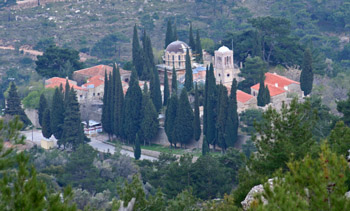
South Chios
The land of mastic with 24 villages.

Armolia
This medieval village is located 20Km SW of the city of Chios butt nowadays is almost re-built. A few remaining arches above the narrow roads in the center of the village give you an idea of its original architecture. There are still a few remains of old houses. In compensation for the changes, all the new houses have gardens full of flowers.
The habitants of Armolia have a long tradition in making and decorating ceramics such as: pitchers, vases, jars, bowls and cups so there is a marvelous collection of local ceramics, and you can still see the potters hand working with clay in the traditional way.
Pyrgi
The entire village is 25 Km south of the town of Chios. The village is unique with the black and white geometrical decor of the outer walls of the houses, with its narrow roads, the innumerable churches and amongst them the 13th century Byzantine church of St. Apostles.
It has been designated a listed monument. It is built like a fortress for protection against the frequent attacks by pirates and Turks. It lies in valley far from the sea. The grey stone houses had doors and windows that faced only the interior of the fortress wall.
At the center of Pyrgi rises the defense tower, where the inhabitants took refuge in the case of attack. The streets of the village, which are cobbled and narrow, are connected to the central tower square. At frequent intervals there are transverse archways supporting the structures, as well as vaults and arches supporting the rooms. The functional character of the houses was geared to defense and thus the inhabitants were able to move about the roofs without being seen.
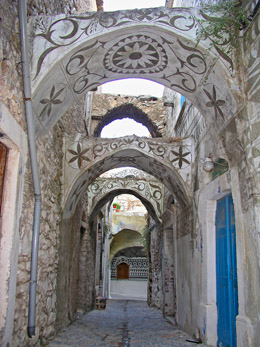
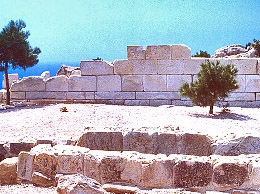
Mavra Volia
(5 Km. from Pyrgi) is a beach with small black pebbles which came from the volcano exploding. There are three beaches, one next to the other, under the same name, with deep, dark blue waters. There are apartments and studios, cafes and taverns offering fresh seafood.
Olympoi
Olympoi is a 14th century medieval village located 31 Km south of the town of Chios and 6 Km far from Pyrgi on the road to Mesta. It has been designated a listed monument. It keeps its houses tied tightly together in what seems like a closed and compact form. The streets are cobbled and narrow.
This type of fortress, a four-cornered structure, was built for protection against the frequent attacks by pirates and Turks. The medieval villages of Chios were built on a fixed plan which may have been imposed by the Genoese.
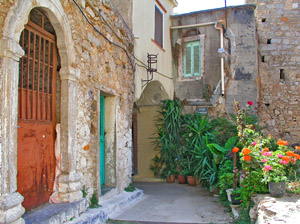
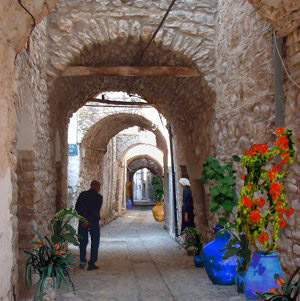
Mesta
It is a perfectly preserved village-castle 35 Km southwest of Chios town of the Byzantine period It has been designated a listed monument.
The Castle-village, takes you back centuries, with its very few changes. It keeps its houses tied tightly together in what seems like a closed and compact form. This type of village was built for protection against the frequent attacks by pirates. All the houses are connected and if you go to one roof you can walk throughout the whole village from one roof to another. Even most alleys are covered with arches.
It lies in small, treeless valleys far from the sea. The grey stone houses had low doors and narrow windows that faced only the interior of the fortress wall. Visiting this village and walking in its narrow alleys is a lifetime experience.
The harbor of Mesta “Limenas” is at a distance of 4 km from the village.
Kalamoti
is about 20.5 Km south of Chios town. It is a traditional village with two storey stone houses and beautiful carved doors. The village has approximately 850 inhabitants, mostly mastic cultivators.
Komi is located 4 Km outside the village of Kalamoti and is among the loveliest beaches of Chios, with a fine sand suitable for beach games and relaxing sunbathing. The area has many hotels, apartments, rooms to let, restaurants, taverns offering fresh seafood, and bars for evening (or allday) fun.
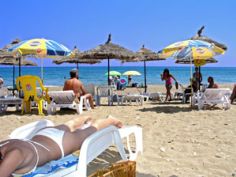
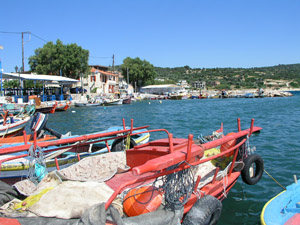
Katarraktis
is a seaside village, 16 km south of Chios, with a small beautiful port for trawlers and small fishing boats.
The village has a nice beach and a lot of taverns serving fresh sea-food.
The old Katarraktis village was built 2 Km southwest form the new one. It is now abandoned, though it attracts the interest of many historians for its ruined medieval houses and Byzantine churches.
North Chios
Vrondados
A seaside town situated among olive trees, gardens, almond trees and many other fruit-bearing trees is located 4 kilometers north of Chios town and in the East of mount Aipos. It has 4.500 people most of whom are excellent seamen, merchants and scientists. In the revolution of 1821 they offered a lot to the Greek Fleet.
Today, there are still ship owners who honour the Chian and Grecian Navy, with their merchant ships. According to some historical elements , Christopher Columbus, visited Vrondados in order to study Nautical charts and get information of experienced seamen who would help him to his great voyage for the discovery of America. Three windmills overlooking the bay area are worth seeing.
On the far side of the Vrondados harbor is the Petra Omirou (Homer’s Stone), a natural rock throne where the poet is said to have sung and taught.

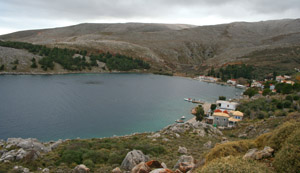
Pantoukios
At the northeastern part of the island. It is a small village at a picturesque bay, close to Sykiada.
Most of the inhabitans live there only during summer and they move to Sykiada in winter.
There is a sea food tavern in the area, but there is not a nice beach to swim.
Lagada
At a distance of 16 km Northwest from the town of Chios, the visitor will find the picturesque village of Lagada. It is a village which descended from the ancient settlements Koila and Kidianda.
Due to the constant attacks on the area, the inhabitants who are mainly merchant marines and fishers.
At Lagada the visitor can rent a room or apartment, and enjoy the traditional sea-food at the restaurants and taverns, which are along the sea side.
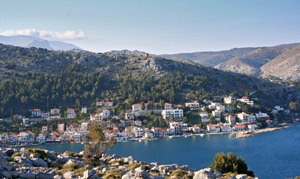
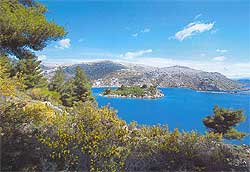
Καρδάμυλα:
28 χλμ. από την πόλη της Χίου, προς τα βόρεια και κατοικούν περίπου 2000 άνθρωποι. Χωρίζονται σε δύο χωριά.
Χωριό Καρδάμυλα (μάρμαρο) στην Βορειανατολική Χίο
Τα Άνω Καρδάμυλα είναι το παλαιό χωριό και απλώνεται στον απόκρημνο λόφο «Βουνό της Γριάς». Το χωριό χαρακτηρίζεται από την παραδοσιακή του αρχιτεκτονική, τους στενούς του δρόμους και τα σπίτια του που είναι χτισμένα κυρίως από πέτρα. Τα παλαιά Καρδάμυλα περιγράφονται από τον Θουκιδίδη. Το χαμηλότερο χωριό ονομάζεται Μάρμαρο κι απέχει 2 χιλιόμετρα από το άνω χωριό. Το Μάρμαρο είναι χτισμένο στο βάθος ενός υπήνεμου κόλπου και προστατεύεται από το μικρό νησάκι που καλείται «Νησί».
5 χλμ. από τα Καρδάμυλα βρίσκεται ο Ναγός στο βόρειο τμήμα της Χίου. Πρόκειται για μία μικρή γραφική παραλία με χρωματιστά μικρά βότσαλα, που προσελκύει πλήθος επισκεπτών. Τα νερά της είναι κρυστάλλινα, πεντακάθαρα και πολύ κρύα καθώς στην περιοχή υπάρχουν αρκετά τρεχούμενα νερά. Η περιοχή διαθέτει ενοικιαζόμενα δωμάτια και ψαροταβέρνες που προσφέρουν θαλασσινό φαγητό. Ένα χλμ. μετά βρίσκεται ο Γιόσονας, μία γραφική παραλία με μικρά και μεγάλα βότσαλα, που συνήθως έχει μεγάλα κύματα. Τα νερά της είναι καθαρά και κρυστάλλινα αλλά κρύα.
Η βόρεια και Βορειοδυτική Χίος διαφέρει σημαντικά από τη νότια και ανατολική πλευρά του νησιού από την άποψη του φυσικού περιβάλλοντος και της παραγωγικότητας.
Τα χωριά είναι μικρά και απομονωμένα και πάντα μακριά από τη θάλασσα.
Κηπουριές:
Στους πρόποδες του Πεληναίου σε ένα όμορφο πράσινο περιβάλλον σε απόσταση 37 χιλιόμετρων από την πόλη της Χίου. Το συγκεκριμένο χωριό έχει γίνει γνωστό από την πέτρινη πλατεία του. Έχει ταβέρνα με καλό φαγητό.
Κουρούνια:
59 χιλιόμετρα από την πόλη είναι γνωστά για την ποικιλία του κρασιού που παραγόταν εκεί.
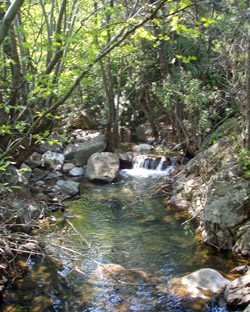
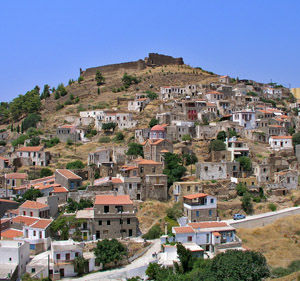
Βολισσός:
Βρίσκεται 40 χιλιόμετρα από την πρωτεύουσα του νησιού και είναι το μεγαλύτερο χωριό στη βορειοδυτική Χίο. Η Βολισσός, κατά τον Θουκυδίδη, ήταν κάποτε μια παλιά αιολική πόλη και φημίζονταν ως η γενέτειρα του Ομήρου. Στην κορυφή του λόφου υπάρχει ένα βυζαντινό κάστρο. Ο Μάναγρος, τα Μαγεμένα, η Γωνιά, τα Λιμνιά (λιμάνι το οποίο συνδέεται ακτοπλοϊκά με το νησί των Ψαρών), τα Λευκάθια, η Λήμνος, η Λάμσα, είναι παραλίες του χωριού που βυθίζονται στην μπλε θάλασσα του Αιγαίου Πελάγους.
Αγία Μαρκέλλα:
6 χλμ από τη Βολισσό βρίσκεται η μονή, το προσκύνημα και η παραλία της Αγίας Μαρκέλλας. Στις 22 Ιουλίου που είναι ημέρα επίσημης αργίας για το νησί, χιλιάδες πιστοί έρχονται από διάφορα σημεία του νησιού αλλά και της Ελλάδας για την εορτή της Αγίας Μαρκέλλας της Χιοπολίτιδος, προστάτιδας της Χίου. Η μεγάλη παραλία που αντικρίζει τα Ψαρά, αποτελείται από άμμο και ψιλό βότσαλο και είναι γνωστή για τα καθαρά αλλά κρύα νερά της. Στο τέλος της παραλίας, υπάρχει το μονοπάτι που οδηγεί στο σημείο όπου μαρτύρησε η Αγία Μαρκέλλα. Σε αυτό το σημείο, αναβλύζει ζεστό νερό μέσα στη θάλασσα.
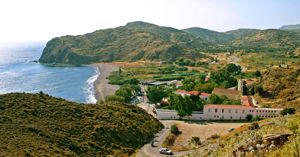
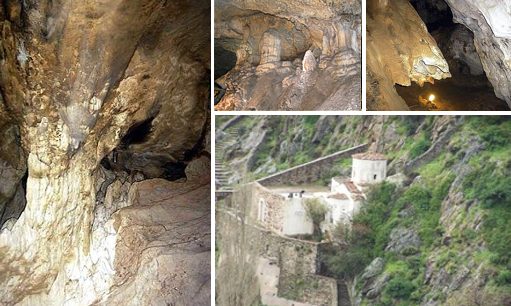
Αγιο Γάλας:
72 χλμ. από την πόλη, το χωριό είναι χτισμένο στη βορειοδυτική Χίο στην κορυφή ενός βραχώδους βουνού. Μοναδικές σπηλιές με σταλακτίτες και σταλαγμίτες εκτείνονται κάτω από το χωριό. Άνθρωποι εγκαταστάθηκαν σε αυτή τη σπηλιά στη διάρκεια της Νεολιθικής Περιόδου (6000-5000 π.Χ) και έζησαν μέχρι το 2700 π.Χ. Κομμάτια από αντικείμενα πηλού δείχνουν ότι η σπηλιά χρησιμοποιούνταν επίσης κι ως ιερό στους Αρχαϊκούς και Ρωμαϊκούς χρόνους. Από την Βυζαντινή περίοδο έως σήμερα έχει εξυπηρετήσει ως τόπος χριστιανικής λατρείας αφιερωμένο στην Παναγία Αγιογαλούσαινα.
Υπάρχει επίσης ένα μικρό εκκλησάκι της Αγίας Άννας μέσα στην σπηλιά. Το όνομα του χωριού σημαίνει γαλακτώδη νερό που πέφτει από τους σταλακτίτες της σπηλιάς.
Βίγλες
Οι Βίγλες που υπάρχουν διάσπαρτες σε όλη την Χίο (ονομάζονται επίσης και Φρυκτωρίες) ήταν παρατηρητήρια σημαντικά για το αμυντικό σύστημα του νησιού από τις αρχές του 11ου αιώνα έως και τις αρχές του 19ου αιώνα μ.Χ.
Πρόκειται για κυλινδρικά κτίρια, (εκτός από τη Βίγλα Κουλά στο κάστρο της Χίου, η οποία είναι ημικυκλική) των 12 έως 20 μέτρων ύψους, με 15 μέτρα διάμετρο.
Στο εσωτερικό τους, οι Βίγλες ήταν γεμάτες από μπάζα κατεδάφισης μέχρι τα 2/3 του ύψους τους. Αν ο Βιγλάτορας (παρατηρητής) έβλεπε ένα εχθρικό πλοίο ενημέρωνε τους άλλους βιγλάτορες ανάβοντας φωτιά τη νύχτα ή με σήματα καπνού τη μέρα έτσι ώστε οι κάτοικοι να έχουν χρόνο να προετοιμάσουν την άμυνά τους.
Έτσι υπήρχαν ξύλα στο εσωτερικό της Βίγλας προκειμένου ο Βιγλάτορας να είναι ικανός να κάνει σήματα αμέσως.
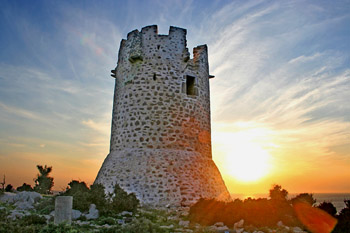
Στον νομό Χίου ανήκουν και τα νησάκια:
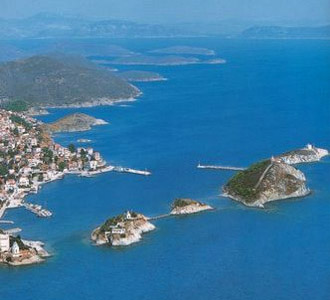
Οινούσες:
Ένα μικρό συγκρότημα από νησιά, γνωστά από τα αρχαία χρόνια για τα γνωστά τους κρασιά. Το λιμάνι είναι μεγάλο και ασφαλές.
Στα μέσα του 17ου αιώνα, αποικήθηκε από βοσκούς από το Χιώτικο χωριό Καρδάμυλα, όντας γεμάτο από κατσίκια και ονομάστηκε Εγνούσα. Από τα μέσα του 19ου αιώνα οι κάτοικοι, εργάζονταν στη θάλασσα, έγινα πλοιοκτήτες και σήμερα έχουν στην ιδιοκτησία τους περισσότερα από 500 πλοία. Πολλά μέλη των φατριών του Λιβανού, του Λεμού και του Πατέρα γεννήθηκαν στις Οινούσσες. Έτσι θεωρούνται ότι είναι το πιο πλούσιο νησί σε όλον τον κόσμο.
Στη Νοτιοδυτική ακτή, μπορείτε να διαλέξετε μεταξύ των παραλίων, Ζεγάπα, Βιλάλη ή Κάστρο.
Ψαρά:
Είναι ένα μικρό νησί κοντά στο βορειοδυτικό τμήμα της Χίου με 400 περίπου κατοίκους. Τα Ψαρά είναι η γενέτειρα του επαναστάτη και ήρωα Κανάρη. Τα Ψαρά αφιέρωσαν τον εμπορικό τους στόλο -τον τρίτο μεγαλύτερο το 1820 στην Ελλάδα μετά από εκείνον της Ύδρας και των Σπετσών- για την απελευθέρωση και πλήρωσαν ακριβά γι’ αυτό. Λέγεται ότι 3.000 από τους 30.000 κατοίκους δραπέτευσαν σε μικρές βάρκες οι οποίες ήταν σωστικές του γαλλικού στόλου, αλλά η πλειοψηφία οπισθοχώρησε στην μπαρουταποθήκη στην κορυφή ενός λόφου και ανατίναξαν τους εαυτούς τους καθώς δεν ήθελαν να παραδοθούν στους αντιπάλους.
